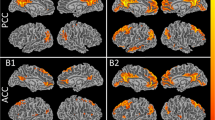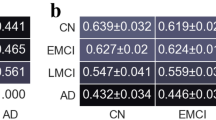Abstract
This study analyzes the connectivity pattern of the default mode network (DMN) in patients with Alzheimer’s disease (AD) in comparison with young and elderly controls using the minimum spanning tree (MST). This tree is a tool from graph theory and connects all the nodes of a graph with the minimum cost. The findings revealed that the alterations of the basic structure represented by the MST might provide valuable insights about the physiopathology of the disease. Additionally, by making use of the MST for functionally clustering the DMN, it was shown that the functional subnetworks comprising the DMN differed among the three subject groups. Nonetheless, there were intact prefrontal and temporal networks in elderly controls and AD patients, as well. The analysis shows that although the topologies of the MST characterized by the degree distributions do not differ significantly among the groups, the DMN of the AD patients exhibits a higher segregation, insomuch that posterior cingulate/precuneus and hippocampus/parahippocampus are heavily isolated from rest of the network. We conclude that the MST can be used effectively for analyzing cortical networks.







Similar content being viewed by others
References
Achard, S., and E. Bullmore. Efficiency and cost of economical brain functional networks. PLoS Comput. Biol. 3(2):e17, 2007. doi:10.1371/journal.pcbi.0030017.
Andrews-Hanna, J. R., J. S. Reidler, J. Sepulcre, R. Poulin, and R. L. Buckner. Functional-anatomic fractionation of the brain’s default network. Neuron 65:550–562, 2010.
Andrews-Hanna, J. R., A. Z. Snyder, J. L. Vincent, C. Lustig, D. Head, M. E. Raichle, and R. L. Buckner. Disruption of large-scale brain systems in advanced aging. Neuron 56:924–935, 2007.
Bassett, D. S., and E. T. Bullmore. Small world brain networks. Neuroscientist 12:512–523, 2006.
Baumgartner, R., R. Somorjai, R. Summers, and W. Richter. Ranking fMRI time courses by minimum spanning trees: assessing coactivation in fMRI. Neuroimage 13:734–742, 2001.
Bellec, P., P. Rosa-Neto, O. C. Lyttelhon, H. Benali, and A. C. Evans. Multi-level bootstrap analysis of stable clusters in resting-state fMRI. Neuroimage 51:1126–1139, 2010.
Benjamini, Y., and Y. Hochberg. Controlling the false discovery rate: a practical and powerful approach to multiple testing. J. R. Statist. Soc. B. 57:289–300, 1995.
Bookheimer, S. Y., M. H. Strojwas, M. S. Cohen, A. M. Saunders, M. A. Pericak-Vance, J. C. Mazziotta, and G. W. Small. Patterns of brain activation in people at risk for Alzheimer’s disease. N. Engl. J. Med. 343:450–456, 2000.
Braak, H., and E. Braak. Neuropathological staging of Alzheimer-related changes. Acta Neuropathol. 82:239–259, 1991.
Broyd, S. J., C. Demanuele, S. Debener, S. K. Helps, C. J. James, and E. J. S. Sonuga-Barke. Default-mode brain dysfunction in mental disorders: a systematic review. Neurosci. Biobehav. R. 33:279–296, 2009.
Buckner, R. L., J. Sepulcre, T. Talukdar, F. M. Krienen, H. Liu, T. Hedden, J. R. Andrews-Hanna, R. A. Sperling, and K. A. Johnson. Cortical hubs revealed by intrinsic functional connectivity: mapping, assessment of stability, and relation to Alzheimer’s disease. J. Neurosci. 29:1860–1873, 2009.
Buckner, R. L., A. Z. Snyder, A. M. Sanders, M. E. Raichle, and J. C. Morris. Functional brain imaging of young, nondemented, and demented older adults. J. Cognit. Neurosci. 12:24–34, 2000.
Bullmore, E., and O. Sporns. Complex brain networks: graph theoretical analysis of structural and functional systems. Nature 10:186–198, 2009.
Damoiseaux, J. S., C. F. Beckmann, E. J. Sanz Arigita, F. Barkhof, Ph. Scheltens, C. J. Stam, S. M. Smith, and S. A. R. B. Rombouts. Reduced resting-state brain activity in the ‘default network’ in normal aging. Cereb. Cortex 18:1856–1864, 2008.
Dauwels, J., F. Vialatte, T. Musha, and A. Cichocki. A comparative study of synchrony measures for the early diagnosis of Alzheimer’s disease based on EEG. Neuroimage 49:668–693, 2010.
de Haan, W., Y. A. L. Pijnenburg, R. L. M. Strijers, Y. van der Made, W. M. van der Flier, P. Scheltens, and C. J. Stam. Functional neural network analysis in frontotemporal dementia and Alzheimer’s disease using EEG and graph theory. BMC Neurosci. 10:101, 2009. doi:10.1186/1471-2202-10-101.
Fox, M. D., and M. E. Raichle. Spontaneous fluctuations in brain activity observed with functional magnetic resonance imaging. Nat. Rev. Neurosci. 8:700–711, 2007.
Fransson, P. How default is the default mode of brain function? Further evidence from intrinsic BOLD signal fluctuations. Neuropsychologia 44:2836–2845, 2006.
Fransson, P., and G. Marrelec. The precuneus/posterior cingulate cortex plays a pivotal role in the default mode network: evidence from a partial correlation network analysis. Neuroimage 42:1178–1184, 2008.
Greicius, M. D., B. Krasnow, A. L. Reiss, and V. Menon. Functional connectivity in the resting brain: a network analysis of the default-mode hypothesis. Proc. Natl. Acad. Sci. USA 100:253–258, 2003.
Greicius, M. D., and V. Menon. Default-mode activity during a passive sensory task: uncoupled from deactivation but impacting activation. J. Cogn. Neurosci. 16:1484–1492, 2004.
Greicius, M. D., G. Srivastava, A. L. Reiss, and V. Menon. Default-mode network activity distinguishes Alzheimer’s disease from healthy aging: evidence from functional MRI. Proc. Natl. Acad. Sci. USA 101:4637–4642, 2004.
Gusnard, D. A., and M. E. Raichle. Searching for a baseline: functional imaging and the resting human brain. Nat. Rev. Neurosci. 2:685–694, 2001.
He, Y., Z. Chen, and A. Evans. Structural insights into aberrant topological patterns of large-scale cortical networks in Alzheimer’s disease. J. Neurosci. 28:4756–4766, 2008.
Jenkinson, M., P. R. Bannister, J. M. Brady, and S. M. Smith. Improved optimisation for the robust and accurate linear registration and motion correction of brain images. Neuroimage 17:825–841, 2002.
Jenkinson, M., and S. M. Smith. A global optimisation method for robust affine registration of brain images. Med. Image Anal. 5:143–156, 2001.
Koch, W., S. Teipel, S. Mueller, K. Buerger, A. L. W. Bokde, H. Hampel, U. Coates, M. Reiser, and T. Meindl. Effects of aging on default mode network activity in resting state fMRI: does the method of analysis matter? Neuroimage 51:280–287, 2010.
Kramer, M. A., U. T. Eden, S. S. Cash, and E. D. Kolaczyk. Network inference with confidence from multivariate time series. Phys. Rev. E 79:061916.1–061916.13, 2009.
Kruskal, J. On the shortest spanning subtree of a graph and the traveling salesman problem. Proc. Am. Math. Soc. 7:48–50, 1956.
Laskaris, N. A., and A. A. Ioannides. Exploratory data analysis of evoked response single trials based on minimal spanning tree. Clin. Neurophysiol. 112:698–712, 2001.
Latora, V., and M. Marchiori. Economic small-world behavior in weighted networks. Eur. Phys. J. B 32:249–263, 2003.
Li, S. J., Z. Li, G. Wu, M. J. Zhang, M. Franczak, and P. G. Antuono. Alzheimer disease: evaluation of a functional MR imaging index as a marker. Radiology 225:253–259, 2002.
Liao, W., H. Chen, and X. Lei. Analysis of fMRI data using improved self organizing mapping and spatio-temporal metric hierarchical clustering. IEEE Trans. Med. Imaging 27:1472–1483, 2008.
Minoshima, S., B. Giordani, S. Berent, K. A. Frey, N. L. Foster, and D. E. Kuhl. Metabolic reduction in the posterior cingulate cortex in very early Alzheimer’s disease. Ann. Neurol. 42:85–94, 1997.
Morgan, V. L., and R. R. Price. The effect of sensorimotor activation on functional connectivity mapping with MRI. Magn. Reson. Imaging 22:1069–1075, 2004.
Morrison, J. H., and P. R. Hof. Life and death of neurons in the aging brain. Science 278:412–419, 1997.
Mosconi, L. Brain glucose metabolism in the early and specific diagnosis of Alzheimer’s disease. Eur. J. Nucl. Med. Mol. I 32:486–510, 2005.
Raichle, M. E., A. M. MacLeod, A. Z. Snyder, W. J. Powers, D. A. Gusnard, and G. L. Shulman. A default mode of brain function. Proc. Natl. Acad. Sci. USA 98:676–682, 2001.
Raz, N., P. Ghisletta, K. M. Rodrigue, K. M. Kennedy, and U. Linderberger. Trajectories of brain aging in middle-aged and older adults: regional and individual differences. Neuroimage 51:501–511, 2010.
Riedl, V., and C. J. Honey. Alzheimer's disease: a search for broken links. J. Neurosci. 28:8148–8149, 2008.
Rombouts, S. A. R. B., F. Barkhof, R. Goekoop, C. J. Stam, and P. Scheltens. Altered resting state networks in mild cognitive impairment and mild Alzheimer’s disease: an fMRI study. Hum. Brain Mapp. 26:231–239, 2005.
Sambataro, F., V. P. Murty, J. H. Callicott, H. Y. Tan, S. Das, D. R. Weinberger, and V. S. Mattay. Age-related alterations in default mode network: impact on working memory performance. Neurobiol. Aging 31:839–852, 2010.
Shen, X., X. Papademetris, and R. T. Constable. Graph-theory based parcellation of functional subunits in the brain from resting-state fMRI data. Neuroimage 50:1027–1035, 2010.
Smith, S. M. Fast robust automated brain extraction. Hum. Brain Mapp. 17:143–155, 2002.
Smith, S. M., M. Jenkinson, M. W. Woolrich, C. F. Beckmann, T. E. J. Behrens, H. Johansen-Berg, P. R. Bannister, M. de Luca, I. Drobnjak, D. E. Flitney, R. K. Niazy, J. Saunders, J. Vickers, Y. Zhang, N. de Stefano, J. M. Brady, and P. M. Matthews. Advances in functional and structural MR image analysis and implementation as FSL. Neuroimage 23(S1):208–219, 2004.
Sorg, C., T. Eichele, V. Riedl, M. Mühlau, V. D. Calhoun, L. Laer, A. Drzezga, H. Förstl, A. Kurtz, C. Zimmer, and A. M. Wohlschlager. Selective changes of resting-state networks in individuals at risk for Alzheimer’s disease. Proc. Natl. Acad. Sci. USA 104:18760–18765, 2007.
Stam, C. J., W. de Haan, A. Daffertshofer, B. F. Jones, I. Manshanden, A. M. van Cappellen van Walsum, T. Montez, J. P. A. Verbunt, J. C. de Munck, B. W. van Dijk, H. W. Berendse, and P. Scheltens. Graph theoretical analysis of magnetoencephalographic functional connectivity in Alzheimer’s disease. Brain 132:213–224, 2009.
Stam, C. J., B. F. Jones, G. Nolte, M. Breakspear, and Ph. Scheltens. Small-world networks and functional connectivity in Alzheimer’s disease. Cereb. Cortex 17:92–99, 2006.
Stanberry, L., R. Nandy, and D. Cordes. Cluster analysis of fMRI data using dendrogram sharpening. Hum. Brain Mapp. 20:201–219, 2003.
Supekar, K., V. Menon, D. Rubin, M. Musen, and M. D. Greicius. Network analysis of intrinsic functional brain connectivity in Alzheimer’s disease. PLoS Comput. Biol. 4(6):e1000100, 2008. doi:10.1371/journal.pcbi.1000100.
Tzourio-Mazoyer, N., B. Landeau, N. Papathanassiou, F. Crivello, O. Etard, N. Delcroix, B. Mazoyer, and M. Joliot. Automated anatomical labeling of activations in SPM using a macroscopic anatomical parcellation of the MNI MRI single-subject brain. Neuroimage 15:273–289, 2002.
van den Huevel, M., R. Mandl, and H. H. Pol. Normalized cut group clustering of resting state fMRI data. PLoS One 3(4):e2001, 2008. doi:10.1371/journal.pone.0002001.
van Hoesen, G. W., J. Parvizi, and C. C. Chu. Orbitofrontal cortex pathology in Alzheimer’s disease. Cereb. Cortex 10:243–251, 2000.
Wang, L., Y. Zang, Y. He, M. Liang, X. Zhang, L. Tian, T. Wu, T. Jiang, and K. Li. Changes in hippocampal connectivity in the early stages of Alzheimer’s disease: evidence from resting state fMRI. Neuroimage 31:496–504, 2006.
Watts, D. J., and S. H. Strogatz. Collective dynamics of small-world networks. Nature 393:440–442, 1998.
Wilson, S. M., I. Molnar-Szakacs, and M. Iacoboni. Beyond superior temporal cortex: intersubject correlations in narrative speech comprehension. Cereb. Cortex 18:230–242, 2008.
Zahn, C. T. Graph theoretical methods for detecting and describing gestalt clusters. IEEE Trans. Comput. C-20:68–86, 1971.
Zhou, Y., J. H. Dougherty, Jr., K. F. Hubner, B. Baid, R. L. Cannon, and R. K. Hutson. Abnormal connectivity in the posterior cingulate and hippocampus in early Alzheimer’s disease and mild cognitive impairment. Alzheimers Dement. 4:265–270, 2008.
Acknowledgments
The author acknowledges the support from the Scientific and Technological Research Council of Turkey (TÜBİTAK) under grant no. 109E202.
Author information
Authors and Affiliations
Corresponding author
Additional information
Associate Editor Nathalie Virag oversaw the review of this article.
Rights and permissions
About this article
Cite this article
Çiftçi, K. Minimum Spanning Tree Reflects the Alterations of the Default Mode Network During Alzheimer’s Disease. Ann Biomed Eng 39, 1493–1504 (2011). https://doi.org/10.1007/s10439-011-0258-9
Received:
Accepted:
Published:
Issue Date:
DOI: https://doi.org/10.1007/s10439-011-0258-9




